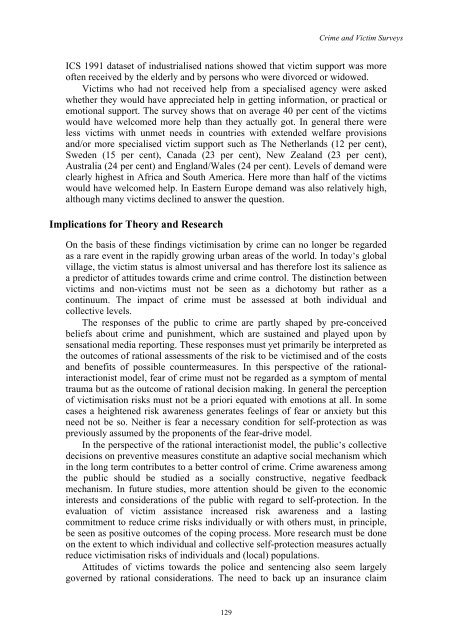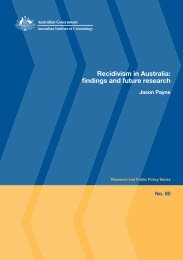Crime and victim surveys - Australian Institute of Criminology
Crime and victim surveys - Australian Institute of Criminology
Crime and victim surveys - Australian Institute of Criminology
Create successful ePaper yourself
Turn your PDF publications into a flip-book with our unique Google optimized e-Paper software.
<strong>Crime</strong> <strong>and</strong> Victim Surveys<br />
ICS 1991 dataset <strong>of</strong> industrialised nations showed that <strong>victim</strong> support was more<br />
<strong>of</strong>ten received by the elderly <strong>and</strong> by persons who were divorced or widowed.<br />
Victims who had not received help from a specialised agency were asked<br />
whether they would have appreciated help in getting information, or practical or<br />
emotional support. The survey shows that on average 40 per cent <strong>of</strong> the <strong>victim</strong>s<br />
would have welcomed more help than they actually got. In general there were<br />
less <strong>victim</strong>s with unmet needs in countries with extended welfare provisions<br />
<strong>and</strong>/or more specialised <strong>victim</strong> support such as The Netherl<strong>and</strong>s (12 per cent),<br />
Sweden (15 per cent), Canada (23 per cent), New Zeal<strong>and</strong> (23 per cent),<br />
Australia (24 per cent) <strong>and</strong> Engl<strong>and</strong>/Wales (24 per cent). Levels <strong>of</strong> dem<strong>and</strong> were<br />
clearly highest in Africa <strong>and</strong> South America. Here more than half <strong>of</strong> the <strong>victim</strong>s<br />
would have welcomed help. In Eastern Europe dem<strong>and</strong> was also relatively high,<br />
although many <strong>victim</strong>s declined to answer the question.<br />
Implications for Theory <strong>and</strong> Research<br />
On the basis <strong>of</strong> these findings <strong>victim</strong>isation by crime can no longer be regarded<br />
as a rare event in the rapidly growing urban areas <strong>of</strong> the world. In today’s global<br />
village, the <strong>victim</strong> status is almost universal <strong>and</strong> has therefore lost its salience as<br />
a predictor <strong>of</strong> attitudes towards crime <strong>and</strong> crime control. The distinction between<br />
<strong>victim</strong>s <strong>and</strong> non-<strong>victim</strong>s must not be seen as a dichotomy but rather as a<br />
continuum. The impact <strong>of</strong> crime must be assessed at both individual <strong>and</strong><br />
collective levels.<br />
The responses <strong>of</strong> the public to crime are partly shaped by pre-conceived<br />
beliefs about crime <strong>and</strong> punishment, which are sustained <strong>and</strong> played upon by<br />
sensational media reporting. These responses must yet primarily be interpreted as<br />
the outcomes <strong>of</strong> rational assessments <strong>of</strong> the risk to be <strong>victim</strong>ised <strong>and</strong> <strong>of</strong> the costs<br />
<strong>and</strong> benefits <strong>of</strong> possible countermeasures. In this perspective <strong>of</strong> the rationalinteractionist<br />
model, fear <strong>of</strong> crime must not be regarded as a symptom <strong>of</strong> mental<br />
trauma but as the outcome <strong>of</strong> rational decision making. In general the perception<br />
<strong>of</strong> <strong>victim</strong>isation risks must not be a priori equated with emotions at all. In some<br />
cases a heightened risk awareness generates feelings <strong>of</strong> fear or anxiety but this<br />
need not be so. Neither is fear a necessary condition for self-protection as was<br />
previously assumed by the proponents <strong>of</strong> the fear-drive model.<br />
In the perspective <strong>of</strong> the rational interactionist model, the public’s collective<br />
decisions on preventive measures constitute an adaptive social mechanism which<br />
in the long term contributes to a better control <strong>of</strong> crime. <strong>Crime</strong> awareness among<br />
the public should be studied as a socially constructive, negative feedback<br />
mechanism. In future studies, more attention should be given to the economic<br />
interests <strong>and</strong> considerations <strong>of</strong> the public with regard to self-protection. In the<br />
evaluation <strong>of</strong> <strong>victim</strong> assistance increased risk awareness <strong>and</strong> a lasting<br />
commitment to reduce crime risks individually or with others must, in principle,<br />
be seen as positive outcomes <strong>of</strong> the coping process. More research must be done<br />
on the extent to which individual <strong>and</strong> collective self-protection measures actually<br />
reduce <strong>victim</strong>isation risks <strong>of</strong> individuals <strong>and</strong> (local) populations.<br />
Attitudes <strong>of</strong> <strong>victim</strong>s towards the police <strong>and</strong> sentencing also seem largely<br />
governed by rational considerations. The need to back up an insurance claim<br />
129















